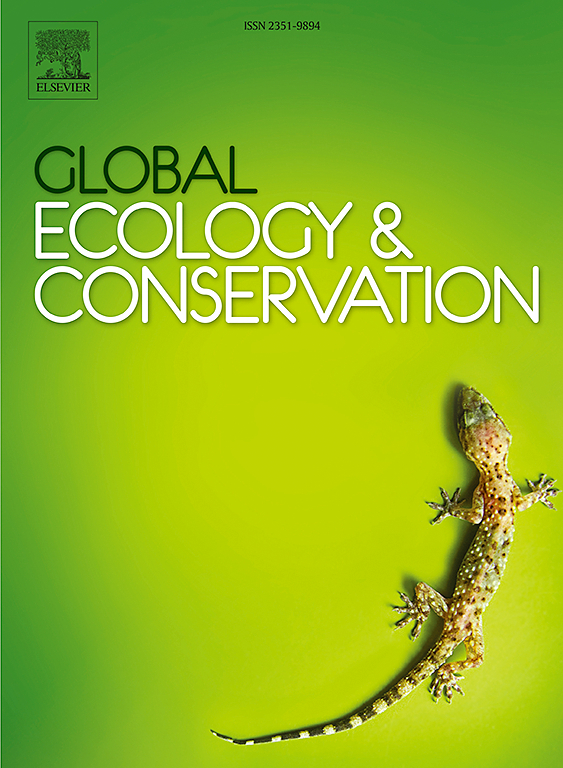降水变化和气候变暖对荒漠草原植被-土壤-微生物关系的影响
IF 3.5
2区 环境科学与生态学
Q1 BIODIVERSITY CONSERVATION
引用次数: 0
摘要
植被-土壤-微生物关系对全球气候和环境变化有着重要影响。气候变化引起的气温和降水波动是植被-土壤-微生物关系动态变化的驱动力。我们的研究在中国宁夏的荒漠草原上进行,涉及五个年降水量水平(33% (R33)、66% (R66)、100% (RCK)、133% (R133) 和 166% (R166))和两个温度水平(敞篷室内部和外部)。我们的目标是确定荒漠草地的植被-土壤-微生物关系如何对降水和气候变暖的变化做出反应。结果表明,降水量与地面生物量、根系生物量和土壤有机碳呈正相关。R166 对植被、土壤和微生物之间的相关性影响最大,而 R33 的影响最小。温度与土壤微生物 α 多样性呈正相关,升温对植被、土壤和微生物之间相关性的影响不如自然温度下显著。降水和升温的组合与地上生物量和土壤呼吸作用呈正相关。降水和增温的组合对植被、土壤和微生物的相关影响比降水和增温的相关影响更大。我们的研究结果为荒漠草原生态系统制定合理的应对策略提供了理论依据。本文章由计算机程序翻译,如有差异,请以英文原文为准。
Effects of precipitation changes and warming on vegetation–soil–microbial relationships in desert grasslands
Vegetation–soil–microbial relationships significantly affect global climatic and environmental changes. Fluctuations in temperature and precipitation caused by climate change are the driving forces of dynamic changes in vegetation–soil–microbial relationships. Our study was conducted in the desert grassland of Ningxia, China, and involved five levels of annual precipitation (33 % (R33), 66 % (R66), 100 % (RCK), 133 % (R133), and 166 % (R166)) and two temperature levels (within and outside the open-top chamber). Our objective was to determine how vegetation–soil–microbial relationships in desert grasslands respond to changes in precipitation and warming. Our results showed that precipitation was positively correlated with above-ground living and root biomass, and soil organic carbon. R166 had the strongest effect on the correlation between vegetation, soil, and microbes, whereas R33 had the weakest effect. Temperature was positively correlated with soil microbial α- diversity, and the effect of warming on the correlation among vegetation, soil, and microbes was less significant than under natural temperature. The combination of precipitation and warming was positively correlated with the above-ground living biomass and soil respiration. The correlation effects of the combination of precipitation and warming on vegetation, soil, and microbes were more substantial than those of precipitation and warming. Our findings provide a theoretical basis for the formulation of reasonable response strategies for desert steppe ecosystems.
求助全文
通过发布文献求助,成功后即可免费获取论文全文。
去求助
来源期刊

Global Ecology and Conservation
Agricultural and Biological Sciences-Ecology, Evolution, Behavior and Systematics
CiteScore
8.10
自引率
5.00%
发文量
346
审稿时长
83 days
期刊介绍:
Global Ecology and Conservation is a peer-reviewed, open-access journal covering all sub-disciplines of ecological and conservation science: from theory to practice, from molecules to ecosystems, from regional to global. The fields covered include: organismal, population, community, and ecosystem ecology; physiological, evolutionary, and behavioral ecology; and conservation science.
 求助内容:
求助内容: 应助结果提醒方式:
应助结果提醒方式:


